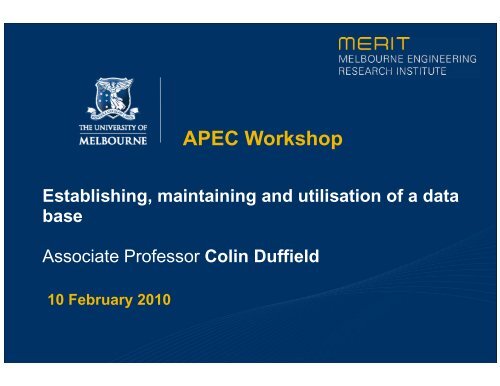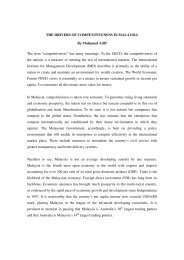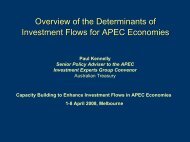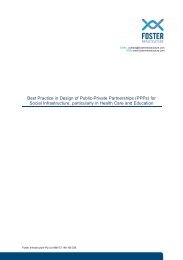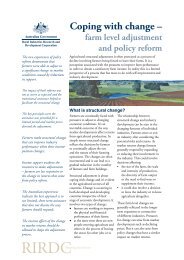Colin Duffield - Australian APEC Study Centre
Colin Duffield - Australian APEC Study Centre
Colin Duffield - Australian APEC Study Centre
You also want an ePaper? Increase the reach of your titles
YUMPU automatically turns print PDFs into web optimized ePapers that Google loves.
<strong>APEC</strong> Workshop<br />
Establishing, maintaining and utilisation of a data<br />
base<br />
Associate Professor <strong>Colin</strong> <strong>Duffield</strong><br />
10 February 2010
Outline / Introduction<br />
1. Databases and their purpose<br />
a) Interest<br />
b) Market understanding – activity<br />
c) Harmonisation of approaches – lower prices and less delays due to<br />
consistency<br />
d) Identification of potential opportunities<br />
e) Policy and practice enhancement<br />
2. Some examples<br />
a) Europe<br />
b) Australia<br />
c) India<br />
d) Researchers<br />
3. Issues<br />
4. Reality check
Example<br />
European<br />
data<br />
[source European PPP<br />
Report 2009 – EPEC]
Infrastructure Australia<br />
[source<br />
www.infrastructureaustr<br />
aslia.gov.au Feb 2010]
[source<br />
www.infrastructureaustr<br />
aslia.gov.au Feb 2010]
[source Linking<br />
Melbourne Authority,<br />
Feb 2010]<br />
Details:<br />
- Transparent<br />
- In depth<br />
- Across all project<br />
areas
Indian database<br />
Eg Report 1 Eg Report 2
Data Capture<br />
Requested data<br />
Project number<br />
Description<br />
Project name<br />
Project delivery method<br />
Project description<br />
Including details of the form of the project contract, e.g. managing<br />
contractor, head contracts, design and construct, public private<br />
partnership<br />
Including brief details of the scope and objective of the project<br />
Project costs<br />
Including details of cost estimates at the various stages of procurement<br />
and actual project costs or forecast of final cost; include a break down in<br />
terms of operating and capital costs. Please record data in nominal<br />
dollars.<br />
Project cost details<br />
Project risk allocation<br />
Brief reasons for any variance and inflation assumptions and the Public<br />
Sector Comparator (PSC) nominal discount rate used.<br />
Details of the risk allocation between parties of the design and/or<br />
construction risk, ownership risk, operational risk, residual value risk.<br />
Standard forms were developed to clearly represent this data. Any<br />
additional explanation or comments regarding these risks was also<br />
requested.
Data Capture cont…<br />
Requested data<br />
Project timeline<br />
Description<br />
Details of estimates at the various stages of procurement for project<br />
duration, important milestones and forecast completion dates. Standard<br />
forms were developed to clearly represent this data. Brief reasons for<br />
deadlines not being achieved were also requested.<br />
Project outcome<br />
Specific outcome (metrics)<br />
Details of the whether project objectives were [are likely to be] achieved,<br />
including any reduction or increase in scope; provide reasons for<br />
objectives not being achieved; include value for money measured as a<br />
percentage of the PSC*; include results of any post-project benefits<br />
assessment that may have taken place if the project has been completed;<br />
include relevant quantitative data for all projects to support project<br />
outcomes where available<br />
Metrics of project outcomes were requested, Eg.: PSC = $100m; Contract<br />
NPV (forecast/actual) = $90; VFM = $10m; VFM % of PSC = 10%
Methodology - periods<br />
• Full Period: $<br />
• Government as well as<br />
PPP/TP affect this<br />
• Stage 3:<br />
• Mostly influenced by PPP<br />
consortium/TP contractor<br />
Original<br />
approval<br />
Final<br />
budget<br />
Contractual<br />
commitment<br />
Actual<br />
final<br />
TIME<br />
(MILESTONES)<br />
FULL PERIOD<br />
STAGE 1<br />
STAGE 2<br />
STAGE 3
Methodology - periods<br />
• Full Period: $<br />
• Government as well as<br />
PPP/TP affect this<br />
• Stage 3:<br />
• Mostly influenced by PPP<br />
consortium/TP contractor<br />
Original<br />
approval<br />
Final<br />
budget<br />
Contractual<br />
commitment<br />
Actual<br />
final<br />
TIME<br />
(MILESTONES)<br />
FULL PERIOD<br />
STAGE 1<br />
STAGE 2<br />
STAGE 3
Construction cost over-runs<br />
Total Cost of Traditional & PPP Projects ($M)<br />
Expected<br />
Cost<br />
Net Cost<br />
Over-run<br />
Final<br />
Cost<br />
% Cost<br />
Over-run<br />
Full Period<br />
Original Approval -<br />
Final<br />
Tradition<br />
al<br />
PPP<br />
3,082.0<br />
4,484.4<br />
1,087.6<br />
519.3<br />
4,169.6<br />
5,003.7<br />
35.3%<br />
11.6%<br />
Stage 3:<br />
Contract - Final<br />
Tradition<br />
al<br />
PPP<br />
4,532.6 672.5 5,205.1 14.8%<br />
4,946.1 57.6 5,003.7 12% 1.2%<br />
Source: ACG/University of Melbourne
Cost performance over project initiation<br />
and delivery (source: VFM report 2009)
Time performance over project initiation<br />
and delivery (source: <strong>Duffield</strong> 2008)<br />
20<br />
Time Performance (based on averages)<br />
15<br />
% La ater than anticip pated<br />
10<br />
5<br />
0<br />
% Earlier r than<br />
antici pated<br />
-5<br />
-10<br />
Original<br />
Announcement<br />
Budget<br />
approval<br />
Contractual<br />
commitment<br />
Actual<br />
Final<br />
Project Milestones PPP Traditional
Issues associated with data collection<br />
1. Confidentiality – commercially sensitive<br />
2. Contractual limitations on sharing of commercial details<br />
3. Dynamic environment means data changes as a project<br />
progresses – what perspective is being sought<br />
4. Different perspectives for different audiences<br />
5. Timing of the release of data is critical<br />
6. Data management is difficult and data can be either incorrect,<br />
dated or misleading if not adequately controlled
Reality check<br />
What may be practical for a generic <strong>APEC</strong> database<br />
• Database for:<br />
a) Interest Achievable<br />
b) Market understanding – activity Achievable<br />
c) Harmonisation of approaches –<br />
detailed learning<br />
d) Identification of potential<br />
opportunities<br />
e) Policy and practice enhancement Unlikely<br />
<br />
<br />
Is a database that achieves points a) & b) (potentially with some mis-<br />
) ) ( y<br />
information) worthwhile
Reference to benchmarking studies:<br />
Wood, P. and <strong>Duffield</strong>, CF 2009, In Pursuit of Additional Value: A<br />
benchmarking study into alliancing in the <strong>Australian</strong> Public Sector.<br />
Melbourne, Department of Treasury and Finance, State of Victoria.<br />
[www.dtf.vic.gov.au… project-alliancing]<br />
<strong>Duffield</strong>, CF 2008, National PPP Forum – Benchmarking <strong>Study</strong>, Phase II:<br />
Report on the performance of PPP projects in Australia when<br />
compared with a representative sample of traditionally procured<br />
infrastructure projects, Report to the PPP Forum by the Melbourne<br />
Engineering Research Institute, 15 November: 44,<br />
http://repository.unimelb.edu.au/10187/3148.<br />
Allen Consulting Group, <strong>Duffield</strong>, CF and Raisbeck, P 2007,<br />
‘Performance of PPPs and Traditional Procurement in Australia’,<br />
Melbourne, Infrastructure Partnerships Australia: 57.
A/Prof <strong>Colin</strong> <strong>Duffield</strong><br />
colinfd@unimelb.edu.au<br />
© Copyright The University of Melbourne 2007 cricos code 00116K


